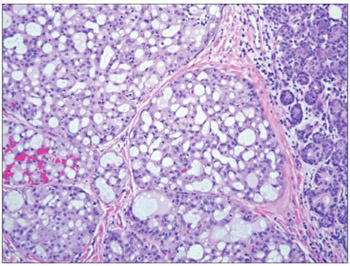Mammary Analogue Secretory Carcinoma (MASC) of the salivary gland: A new tumor entity
DOI:
https://doi.org/10.17305/bjbms.2016.1321Keywords:
salivary gland, carcinoma, mammary analogue, MASCAbstract
Mammary analogue secretory carcinoma (MASC) is a recently described low-grade malignant tumor of the salivary glands, biologically and morphologically equivalent to secretory breast carcinoma. We give a brief overview of this new entity, including morphological, immunohistochemical, molecular-genetic, clinical, epidemiologic features, differential diagnosis, and outcome results.
Citations
Downloads
References
Skálová A, Vanecek T, Sima R, Laco J, Weinreb I, Perez-Ordonez B, et al.
Mammary analogue secretory carcinoma of salivary glands, containing the ETV6-NTRK3 fusion gene: a hitherto undescribed salivary gland tumor entity. Am J Surg Pathol. 2010;34:599-608.
DOI: 10.1097/PAS.0b013e3181d9efcc.
Wenig BM. Atlas of head and neck pathology. 3rd ed. Philadelphia: Elsevier; 2016.
Oza N, Sanghvi K, Shet T, Patil A, Menon S, Ramadwar M, et al. Mammary analogue secretory carcinoma of parotid: is preoperative cytological diagnosis possible? Diagn Cytopathol. 2016 Mar 4. [Epub ahead of print]
http://dx.doi.org/10.1002/dc.23459.
Jung MJ, Kim SY, Nam SY, Roh JL, Choi SH, Lee JH, et al. Aspiration cytology of mammary analogue secretory carcinoma of the salivary gland. Diagn Cytopathol. 2015;43:287-93.
http://dx.doi.org/10.1002/dc.23208.
Urano M, Nagao T, Miyabe S, Ishibashi K, Higuchi K, Kuroda M. Characterization of mammary analogue secretory carcinoma of the salivary gland: discrimination from its mimics by the presence of the ETV6-NTRK3 translocation and novel surrogate markers. Hum Pathol. 2015;46:94-103.
http://dx.doi.org/10.1016/j.humpath.2014.09.012.
Ito Y, Ishibashi K, Masaki A, Fujii K, Fujiyoshi Y, Hattori H, et al. Mammary analogue secretory carcinoma of salivary glands: a clinicopathologic and molecular study including 2 cases harboring ETV6-X fusion. Am J Surg Pathol. 2015;39:602-10.
http://dx.doi.org/10.1097/PAS.0000000000000392.
Skálová A, Vanecek T, Simpson RH, Laco J, Majewska H, Baneckova M, et al. Mammary analogue secretory carcinoma of salivary glands: molecular analysis of 25 ETV6 gene rearranged tumors with lack of detection of classical ETV6-NTRK3 fusion transcript by standard RT-PCR: report of 4 cases harboring ETV6-X gene fusion. Am J Surg Pathol. 2016;40:3-13.
http://dx.doi.org/10.1097/PAS.0000000000000537.
Skálová A, Vanecek T, Majewska H, Laco J, Grossmann P, Simpson RH, et al. Mammary analogue secretory carcinoma of salivary glands with high-grade transformation: report of 3 cases with the ETV6-NTRK3 gene fusion and analysis of TP53, β-catenin, EGFR, and CCND1 genes. Am J Surg Pathol. 2014;38:23-33.
http://dx.doi.org/10.1097/PAS.0000000000000088.
Drilon A, Li G, Dogan S, Gounder M, Shen R, Arcila M, et al. What hides behind the MASC: clinical response and acquired resistance to entrectinib after ETV6-NTRK3 identification in a mammary analogue secretory carcinoma (MASC). Ann Oncol. 2016 Feb 15. pii: mdw042. [Epub ahead of print]
http://dx.doi.org/10.1093/annonc/mdw042.
Luk PP, Selinger CI, Eviston TJ, Lum T, Yu B, O'Toole SA, et al. Mammary analogue secretory carcinoma: an evaluation of its clinicopathological and genetic characteristics. Pathology. 2015; 47:659-66. http://dx.doi.org/10.1097/PAT.0000000000000322.
Majewska H, Skálová A, Stodulski D, Klimková A, Steiner P, Stankiewicz C, et al. Mammary analogue secretory carcinoma of salivary glands: a new entity associated with ETV6 gene rearrangement. Virchows Arch. 2015;466:245-54. http://dx.doi.org/10.1007/s00428-014-1701-8.

Downloads
Additional Files
Published
License
Copyright (c) 2016 Bosnian Journal of Basic Medical Sciences

This work is licensed under a Creative Commons Attribution 4.0 International License.
How to Cite
Accepted 2016-04-19
Published 2016-08-02









